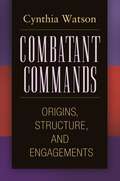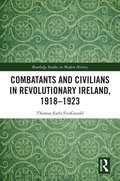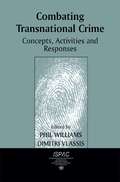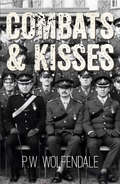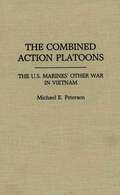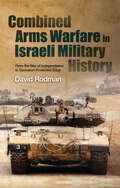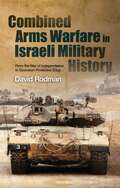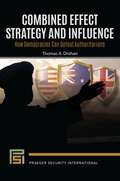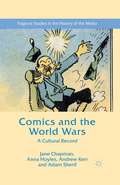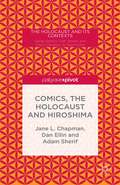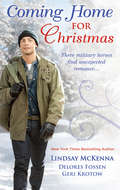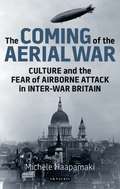- Table View
- List View
Combatant Commands: Origins, Structure, and Engagements (Praeger Security International)
by Cynthia A. WatsonA one-stop resource for information about U.S. military commands and their organizations, this book describes the six geographic combat commands and analyzes their contributions to national security.The first book on the topic, Combatant Commands: Origins, Structure, and Engagements is a unique introduction to the geographic commands that are now at the heart of the U.S. military deployment abroad. The book begins with a description of the six commands—Northern Command, Pacific Command, Central Command, Southern Command, European Command, and Africa Command—explaining how they fit into the current national security establishment. Each command is discussed in depth, including areas of responsibility, subcommands, priorities, threats faced, and engagement institutions.The history of joint combatant commands is outlined as well, particularly the impact of the Root Reforms of the early 20th century, the push for the 1947 National Security Act, and the 1986 Goldwater-Nichols Military Reform Act. In this way, the evolution of combatant commands becomes a window through which to view changes in the U.S. military. Geographic combatant commands are vital to national security. By understanding how they work, readers will better understand where our military is today and where it may be headed.
Combatants and Civilians in Revolutionary Ireland, 1918-1923 (Routledge Studies in Modern History)
by Thomas Earls FitzGeraldThis book is based on original research into intimidation and violence directed at civilians by combatants during the revolutionary period in Ireland, considering this from the perspectives of the British, the Free State and the IRA. The book combines qualitative and quantitative approaches, and focusses on County Kerry, which saw high levels of violence. It demonstrates that violence and intimidation against civilians was more common than clashes between combatants and that the upsurge in violence in 1920 was a result of the deployment of the Black and Tans and Auxiliaries, particularly in the autumn and winter of that year. Despite the limited threat posed by the IRA, the British forces engaged in unprecedented and unprovoked violence against civilians. This study stresses the increasing brutality of the subsequent violence by both sides. The book shows how the British had similar methods and views as contemporary counter-revolutionary groups in Europe. IRA violence, however, was, in part, an attempt to impose homogeneity as, beneath the Irish republican narrative of popular approval, there lay a recognition that universal backing was never in fact present. The book is important reading for students and scholars of the Irish revolution, the social history of Ireland and inter-war European violence.
Combatants and Civilians in Revolutionary Ireland, 1918-1923 (Routledge Studies in Modern History)
by Thomas Earls FitzGeraldThis book is based on original research into intimidation and violence directed at civilians by combatants during the revolutionary period in Ireland, considering this from the perspectives of the British, the Free State and the IRA. The book combines qualitative and quantitative approaches, and focusses on County Kerry, which saw high levels of violence. It demonstrates that violence and intimidation against civilians was more common than clashes between combatants and that the upsurge in violence in 1920 was a result of the deployment of the Black and Tans and Auxiliaries, particularly in the autumn and winter of that year. Despite the limited threat posed by the IRA, the British forces engaged in unprecedented and unprovoked violence against civilians. This study stresses the increasing brutality of the subsequent violence by both sides. The book shows how the British had similar methods and views as contemporary counter-revolutionary groups in Europe. IRA violence, however, was, in part, an attempt to impose homogeneity as, beneath the Irish republican narrative of popular approval, there lay a recognition that universal backing was never in fact present. The book is important reading for students and scholars of the Irish revolution, the social history of Ireland and inter-war European violence.
Combatants of Muslim Origin in European Armies in the Twentieth Century: Far From Jihad
by Xavier Bougarel Raphaëlle Branche Cloé DrieuDuring the two World Wars that marked the 20th century, hundreds of thousands of non-European combatants fought in the ranks of various European armies. The majority of these soldiers were Muslims from North Africa, Sub-Saharan Africa, Central Asia, or the Indian Subcontinent.How are these combatants considered in existing historiography? Over the past few decades, research on war has experienced a wide-reaching renewal, with increased emphasis on the social and cultural dimensions of war, and a desire to reconstruct the experience and viewpoint of the combatants themselves. This volume reintroduces the question of religious belonging and practice into the study of Muslim combatants in European armies in the 20th century, focusing on the combatants' viewpoint alongside that of the administrations and military hierarchy.
Combatants of Muslim Origin in European Armies in the Twentieth Century: Far From Jihad
by Xavier Bougarel Raphaëlle Branche Cloé DrieuDuring the two World Wars that marked the 20th century, hundreds of thousands of non-European combatants fought in the ranks of various European armies. The majority of these soldiers were Muslims from North Africa, Sub-Saharan Africa, Central Asia, or the Indian Subcontinent.How are these combatants considered in existing historiography? Over the past few decades, research on war has experienced a wide-reaching renewal, with increased emphasis on the social and cultural dimensions of war, and a desire to reconstruct the experience and viewpoint of the combatants themselves. This volume reintroduces the question of religious belonging and practice into the study of Muslim combatants in European armies in the 20th century, focusing on the combatants' viewpoint alongside that of the administrations and military hierarchy.
Combating Jihadism: American Hegemony and Interstate Cooperation in the War on Terrorism
by Barak MendelsohnAlthough terrorism is an age-old phenomenon, jihadi ideology is distinctive in its ambition to abandon the principle of state sovereignty, overthrow the modern state system, and replace it with an extremely radical interpretation of an Islamic world order. These characteristics reflect a radical break from traditional objectives promoted by terrorist groups. In Combating Jihadism Barak Mendelsohn argues that the distinctiveness of the al-Qaeda threat led the international community to change its approach to counterterrorism. Contrary to common yet erroneous conceptions, the United States, in its role as a hegemon, was critical for the formulation of a multilateral response. While most analyses of hegemony have focused on power, Mendelsohn firmly grounds the phenomenon in a web of shared norms and rules relating to the hegemon’s freedom of action. Consequently, he explains why US leadership in counterterrorism efforts was in some spheres successful, when in others it failed or did not even seek to establish multilateral collaborative frameworks. Tracing the ways in which international cooperation has stopped terrorist efforts, Combating Jihadism provides a nuanced, innovative, and timely reinterpretation of the war on terrorism and the role of the United States in leading the fight against al-Qaeda and its affiliates.
Combating Jihadism: American Hegemony and Interstate Cooperation in the War on Terrorism
by Barak MendelsohnAlthough terrorism is an age-old phenomenon, jihadi ideology is distinctive in its ambition to abandon the principle of state sovereignty, overthrow the modern state system, and replace it with an extremely radical interpretation of an Islamic world order. These characteristics reflect a radical break from traditional objectives promoted by terrorist groups. In Combating Jihadism Barak Mendelsohn argues that the distinctiveness of the al-Qaeda threat led the international community to change its approach to counterterrorism. Contrary to common yet erroneous conceptions, the United States, in its role as a hegemon, was critical for the formulation of a multilateral response. While most analyses of hegemony have focused on power, Mendelsohn firmly grounds the phenomenon in a web of shared norms and rules relating to the hegemon’s freedom of action. Consequently, he explains why US leadership in counterterrorism efforts was in some spheres successful, when in others it failed or did not even seek to establish multilateral collaborative frameworks. Tracing the ways in which international cooperation has stopped terrorist efforts, Combating Jihadism provides a nuanced, innovative, and timely reinterpretation of the war on terrorism and the role of the United States in leading the fight against al-Qaeda and its affiliates.
Combating Jihadism: American Hegemony and Interstate Cooperation in the War on Terrorism
by Barak MendelsohnAlthough terrorism is an age-old phenomenon, jihadi ideology is distinctive in its ambition to abandon the principle of state sovereignty, overthrow the modern state system, and replace it with an extremely radical interpretation of an Islamic world order. These characteristics reflect a radical break from traditional objectives promoted by terrorist groups. In Combating Jihadism Barak Mendelsohn argues that the distinctiveness of the al-Qaeda threat led the international community to change its approach to counterterrorism. Contrary to common yet erroneous conceptions, the United States, in its role as a hegemon, was critical for the formulation of a multilateral response. While most analyses of hegemony have focused on power, Mendelsohn firmly grounds the phenomenon in a web of shared norms and rules relating to the hegemon’s freedom of action. Consequently, he explains why US leadership in counterterrorism efforts was in some spheres successful, when in others it failed or did not even seek to establish multilateral collaborative frameworks. Tracing the ways in which international cooperation has stopped terrorist efforts, Combating Jihadism provides a nuanced, innovative, and timely reinterpretation of the war on terrorism and the role of the United States in leading the fight against al-Qaeda and its affiliates.
Combating Jihadism: American Hegemony and Interstate Cooperation in the War on Terrorism
by Barak MendelsohnAlthough terrorism is an age-old phenomenon, jihadi ideology is distinctive in its ambition to abandon the principle of state sovereignty, overthrow the modern state system, and replace it with an extremely radical interpretation of an Islamic world order. These characteristics reflect a radical break from traditional objectives promoted by terrorist groups. In Combating Jihadism Barak Mendelsohn argues that the distinctiveness of the al-Qaeda threat led the international community to change its approach to counterterrorism. Contrary to common yet erroneous conceptions, the United States, in its role as a hegemon, was critical for the formulation of a multilateral response. While most analyses of hegemony have focused on power, Mendelsohn firmly grounds the phenomenon in a web of shared norms and rules relating to the hegemon’s freedom of action. Consequently, he explains why US leadership in counterterrorism efforts was in some spheres successful, when in others it failed or did not even seek to establish multilateral collaborative frameworks. Tracing the ways in which international cooperation has stopped terrorist efforts, Combating Jihadism provides a nuanced, innovative, and timely reinterpretation of the war on terrorism and the role of the United States in leading the fight against al-Qaeda and its affiliates.
Combating Jihadism: American Hegemony and Interstate Cooperation in the War on Terrorism
by Barak MendelsohnAlthough terrorism is an age-old phenomenon, jihadi ideology is distinctive in its ambition to abandon the principle of state sovereignty, overthrow the modern state system, and replace it with an extremely radical interpretation of an Islamic world order. These characteristics reflect a radical break from traditional objectives promoted by terrorist groups. In Combating Jihadism Barak Mendelsohn argues that the distinctiveness of the al-Qaeda threat led the international community to change its approach to counterterrorism. Contrary to common yet erroneous conceptions, the United States, in its role as a hegemon, was critical for the formulation of a multilateral response. While most analyses of hegemony have focused on power, Mendelsohn firmly grounds the phenomenon in a web of shared norms and rules relating to the hegemon’s freedom of action. Consequently, he explains why US leadership in counterterrorism efforts was in some spheres successful, when in others it failed or did not even seek to establish multilateral collaborative frameworks. Tracing the ways in which international cooperation has stopped terrorist efforts, Combating Jihadism provides a nuanced, innovative, and timely reinterpretation of the war on terrorism and the role of the United States in leading the fight against al-Qaeda and its affiliates.
Combating Jihadism: American Hegemony and Interstate Cooperation in the War on Terrorism
by Barak MendelsohnAlthough terrorism is an age-old phenomenon, jihadi ideology is distinctive in its ambition to abandon the principle of state sovereignty, overthrow the modern state system, and replace it with an extremely radical interpretation of an Islamic world order. These characteristics reflect a radical break from traditional objectives promoted by terrorist groups. In Combating Jihadism Barak Mendelsohn argues that the distinctiveness of the al-Qaeda threat led the international community to change its approach to counterterrorism. Contrary to common yet erroneous conceptions, the United States, in its role as a hegemon, was critical for the formulation of a multilateral response. While most analyses of hegemony have focused on power, Mendelsohn firmly grounds the phenomenon in a web of shared norms and rules relating to the hegemon’s freedom of action. Consequently, he explains why US leadership in counterterrorism efforts was in some spheres successful, when in others it failed or did not even seek to establish multilateral collaborative frameworks. Tracing the ways in which international cooperation has stopped terrorist efforts, Combating Jihadism provides a nuanced, innovative, and timely reinterpretation of the war on terrorism and the role of the United States in leading the fight against al-Qaeda and its affiliates.
Combating Transnational Crime: Concepts, Activities and Responses
by Phil Williams Dimitri VlassisThis work examines the challenges posed by transnational crime and the steps being taken by the international community to meet these challenges. It offers comprehensive analysis of different forms of transnational crime and the various responses that are being developed.
Combating Transnational Crime: Concepts, Activities and Responses
by Dimitri Vlassis Phil WilliamsThis work examines the challenges posed by transnational crime and the steps being taken by the international community to meet these challenges. It offers comprehensive analysis of different forms of transnational crime and the various responses that are being developed.
Combats & Kisses
by P. W. WolfendaleThere comes a time in life when you have to walk away from your family and surround yourself with people who will be your everlasting friends, people who will be there for you in times of need, and people that will never let you suffer alone. As a sixteen year old lad, and still attached to my mother’s apron strings, I decided to fulfil my teenage dreams and join the Army. This is a true in-depth encounter spanning over ten years of military service. How the next ten years unfolded is something I felt I needed to share with the world. Basic training, military pranks, letters from our loved ones, the endless civil war in Northern Ireland, heartache, bullying, and last but not least, our fallen heroes. Feeling all alone as I waited for the train to arrive to take me away from my family and friends is a day I shall never forget.
The Combined Action Platoons: The U.S. Marines' Other War in Vietnam (Praeger Security International Ser.)
by Michael PetersonThis is the first comprehensive history for the academic reader of the Combined Action Program (CAP) in Vietnam. Created as a response by the U.S. Marines to what was known as the other war in Vietnam, the CAP Program was comprised of platoons each combining a fourteen man marine rifle squad, a navy corpsman, and a platoon of South Vietnamese militia. These CAP units were unique to the war. Their function was to capture and hold rather than to search and destroy. While the main forces of the Army and Marines all too often waged war on the Vietnamese hamlets, the CAP marines waged war from the hamlets. Their intent was to keep the hamlet intact. The uniqueness of the CAP Program justifies this study not only from an historical and political perspective but also sociologically. The CAP Marines were among the few Americans who lived with the Vietnamese in their own setting for long periods of time, developing community projects and civic action programs. The 1980s has brought about a resurgence of valuable research, the declassification of official documentation, and most important, an emotional distance from the trauma of defeat. The author takes full advantage of these conditions to present a thorough and comprehensive history and civic program analysis.Many critics of the Vietnam War now agree that the tactics of the Combined Action Program were among the most promising of the war. The CAP Marines fought a deadly and personal war with the Viet Cong and the North Vietnamese Army. In this volume, the author achieves his twofold objective. He not only provides a valuable historical account of the Program, but also analyzes the civic action and community development projects undertaken by the CAP Marines. His study is done with an eye to the future as U.S. counterinsurgency has again found expression in other Third World conflicts.
Combined Arms Warfare in Israeli Military History: From the War of Independence to Operation Protective Edge
by David RodmanCombined arms warfare (CAW) -- the integration of different arms on the battlefield (e.g., armor, infantry, artillery, aircraft, and engineers) in order to achieve maximal efficiency there -- is as old as war itself. Every army across both time and space that has engaged in combat has practiced one version or another of CAW, whether consciously or otherwise. The Israel Defenxse Forces (IDF) has been no exception to the rule. This book traces the Israeli experience with CAW from the countrys War of Independence in 194749 (against a coalition of Arab states) through Operation Protective Edge in 2014 (against a coalition of Hamas-led terrorist/insurgent groups). It describes and analyzes the IDFs practice of CAW in each interstate war (IW), asymmetrical war (AW), and low-intensity conflict (LIC) that Israel has fought since the countrys establishment in the mid-twentieth century. The book also highlights the Israeli approach to CAW in respect of special operations (SPEC OPS). With no end in sight to the ArabIsraeli conflict, and with further hostilities between Israel and its neighbors virtually assured in the future, Combined Arms Warfare in Israeli Military History constitutes an essential addition to the literature about Middle Eastern warfare. This book is aimed primarily at the academic and research community, but it is fully accessible to anyone with an interest in Israeli military history.
Combined Arms Warfare in Israeli Military History: From the War of Independence to Operation Protective Edge
by David RodmanCombined arms warfare (CAW) -- the integration of different arms on the battlefield (e.g., armor, infantry, artillery, aircraft, and engineers) in order to achieve maximal efficiency there -- is as old as war itself. Every army across both time and space that has engaged in combat has practiced one version or another of CAW, whether consciously or otherwise. The Israel Defenxse Forces (IDF) has been no exception to the rule. This book traces the Israeli experience with CAW from the countrys War of Independence in 194749 (against a coalition of Arab states) through Operation Protective Edge in 2014 (against a coalition of Hamas-led terrorist/insurgent groups). It describes and analyzes the IDFs practice of CAW in each interstate war (IW), asymmetrical war (AW), and low-intensity conflict (LIC) that Israel has fought since the countrys establishment in the mid-twentieth century. The book also highlights the Israeli approach to CAW in respect of special operations (SPEC OPS). With no end in sight to the ArabIsraeli conflict, and with further hostilities between Israel and its neighbors virtually assured in the future, Combined Arms Warfare in Israeli Military History constitutes an essential addition to the literature about Middle Eastern warfare. This book is aimed primarily at the academic and research community, but it is fully accessible to anyone with an interest in Israeli military history.
Combined Effect Strategy and Influence: How Democracies Can Defeat Authoritarians (Praeger Security International)
by Thomas A. DrohanOffering a competitive strategy to defeat authoritarians' all-domain warfare, this book suggests a new combined effects and influence framework for democracies to employ before deterrence fails.Breaking new ground in this comprehensive study, retired Brigadier General Thomas A. Drohan reforms an entrenched legacy concept-coercive compellence and deterrence. The book's framework synthesizes brute force, coercion, combined arms, and concepts of operations into combined effects and concepts of influence, including narrative warfare with cognitive exploits. The survey of competitive strategy at the beginning of the book spans a time frame from the thinking of ancient civilizations all the way to artificial intelligence, providing broad historical context for this model. The contemporary cases that test the model focus on complex competition and confrontation during the past 75 years.Combined Effect Strategy and Influence is unique in its critique of democracies' dominant paradigm of international security and its broad, specific framework ready for strategists, analysts, planners, and operators to apply to current threats. Students, researchers, and any leader interested in developing superior strategy will value the book's insights on gaining an advantage against emerging threats.
Combined Effect Strategy and Influence: How Democracies Can Defeat Authoritarians (Praeger Security International)
by Thomas A. DrohanOffering a competitive strategy to defeat authoritarians' all-domain warfare, this book suggests a new combined effects and influence framework for democracies to employ before deterrence fails.Breaking new ground in this comprehensive study, retired Brigadier General Thomas A. Drohan reforms an entrenched legacy concept-coercive compellence and deterrence. The book's framework synthesizes brute force, coercion, combined arms, and concepts of operations into combined effects and concepts of influence, including narrative warfare with cognitive exploits. The survey of competitive strategy at the beginning of the book spans a time frame from the thinking of ancient civilizations all the way to artificial intelligence, providing broad historical context for this model. The contemporary cases that test the model focus on complex competition and confrontation during the past 75 years.Combined Effect Strategy and Influence is unique in its critique of democracies' dominant paradigm of international security and its broad, specific framework ready for strategists, analysts, planners, and operators to apply to current threats. Students, researchers, and any leader interested in developing superior strategy will value the book's insights on gaining an advantage against emerging threats.
Come Back To Me: Come Back To Me; Stay With Me; Run Away With Me
by Mila GrayCome back to me. That was the very last thing I said to him.Always. The very last thing he said to me.Home on leave in sunny California, Marine and local lothario Kit Ryan finds himself dangerously drawn to his best friend's sister, Jessa - the one girl he can't have.But Kit's not about to let a few obstacles stand in his way and soon Jessa's falling for his irresistible charms. What starts out as a summer romance of secret hook-ups and magical first times quickly develops into a passionate love affair that turns both their worlds upside down. When summer's over and it's time for Kit to redeploy, neither Kit nor Jessa are ready to say goodbye. Jessa's finally following her dreams and Kit's discovered there's someone he'd sacrifice everything for. Jessa's prepared to wait for Kit no matter what. But when something more than distance and time rips them apart they're forced to decide whether what they have is really worth fighting for. Come Back To Me is a breathtaking, scorchingly hot story about love, friendship, family and finding your way back from the edge of heartbreak from Mila Gray.
Comfort Women And Sex In The Battle Zone (PDF)
by Ikuhiko HataComfort Women and Sex in the Battle Zone is an exhaustive examination of the controversial issue of comfort women, who provided sexual services to Japanese soldiers before and during World War II. This book provides extensive documents and narratives by witnesses to shed light on the reality of these women who worked in the battle zone. The book also covers Japan's political and diplomatic disagreements with neighboring nations, in particular South Korea and China, over this issue, as well as other international reactions, including the U.S. House of Representatives resolution that urged the Japanese government to apologize to former comfort women. The book is an English translation of the Japanese version first published in 1999 and reprinted several times, with additional sections covering recent developments.
Comics and the World Wars: A Cultural Record (Palgrave Studies in the History of the Media)
by Jane L. Chapman Andrew Kerr Adam Sherif Anna HoylesThis transnational, interdisciplinary study argues for the use of comics as a primary source. In recuperating currently unknown or neglected strips the authors demonstrate that these examples, produced during the World Wars, act as an important cultural record, providing, amongst other information, a barometer for contemporary popular thinking.
Comics, the Holocaust and Hiroshima (The Holocaust and its Contexts)
by Jane L. Chapman Dan Ellin Adam SherifComics, the Holocaust and Hiroshima breaks new ground for history by exploring the relationship between comics as a cultural record, historiography, memory and trauma studies. Comics have a dual role as sources: for gauging awareness of the Holocaust and through close analysis, as testimonies and narratives of childhood emotions and experiences.
Coming Home For Christmas: Christmas Angel / Unexpected Gift / Navy Joy
by Delores Fossen Geri Krotow Lindsay McKennaThree stories salute the romance of holiday homecomings Christmas Angel by Lindsay McKenna
The Coming of the Aerial War: Culture and the Fear of Airborne Attack in Inter-War Britain (International Library of Twentieth Century History)
by Michele HaapamäkiIn the first half of the 20th century the possibility of flight opened up entirely new avenues of thought and exploration. In the age of H.G. Wells and Biggles, the opening up of the air to balloons and planes - the Royal Flying Corps was founded in 1912 - appealed to concepts of courage and bravery which would be both encouraged and undermined by the experiences of World War I. The sky also held new terrors for everyday people who were now within reach of an airborne enemy - these fears included the possibilities of bombing, poison gas, surveillance and social control. This duality of fear and enthusiasm drove the Air Raid Precaution movement, while vocal elements in the press and in parliament called for radical plans to cope with apocalyptic scenarios. Here, Michele Haapamäki charts the history of flight and of war in the air in the early 20th century, addressing the key issues of interwar historiography such as patriotism, fear, masculinity and propaganda.
